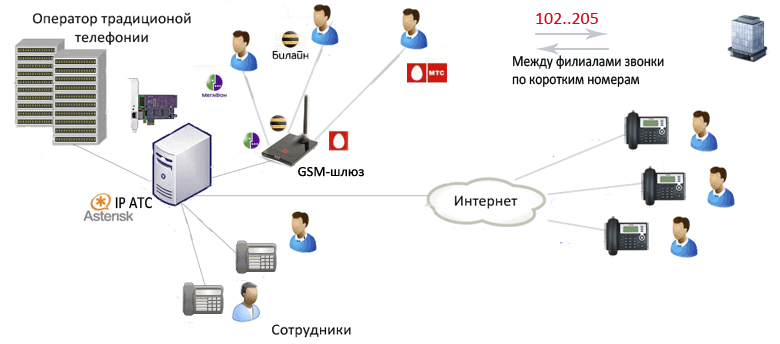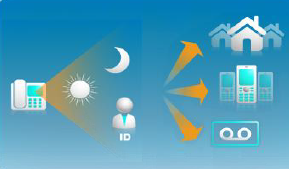Asterisk for the head: how to recoup the investment?
Corporate IP telephony systems are gaining momentum. Most companies use Asterisk's Open Source IP PBX .
Although Asterisk itself is free and there are ready-made distributions with a web interface on the market, but investments in modernizing corporate communications can still be significant through the purchase of equipment (IP phones, VoIP gateways, telephony boards). MyAsterisk Team
specialists analyzed how to evaluate the return on investment in corporate IP telephony. One of the indicators for evaluating the return on investment is the reduction in communication costs

. The combination of offices in one space will make calls between branches free, intercity via SIP-telephony and calls to mobile via GSM-gateway will further reduce costs.
But even such an assessment does not always lead managers to make decisions on the transition to IP-telephony.
In addition to reducing costs, corporate IP-telephony helps to increase profits and sales, as well as business efficiency in general!

According to experts, more than 72.49% of company communications with customers is carried out by telephone.
A study conducted by Arctell, showed that 31.72% of calls of potential customers do not reach managers because of the "undetection"
Customers hear a busy tone and call your competitors
No direct connection to the desired department or employee
The employee is absent from the workplace, or is already talking on the phone and cannot answer another call.
The specialist is on the road, or in another office, to contact him, you need to call one more time.
The company receives 50 customer calls daily, 10 buy (20% conversion). Each client brings 1,000 rubles of net profit.


The client, having called the company, will hear a voice greeting and will choose which department or employee to connect. This approach will offload the secretary and direct calls directly to the desired department or employee, even when he is not in the workplace.

If all employees are busy and talking on the phone, then the call will be sent to the waiting line, where the approximate waiting time will be announced to the client.
In the process of waiting, the client can be played with advertising information or a pleasant melody.

If no one picks up the phone, the system redirects the call to a mobile or other employee number, or prompts the caller to leave a voice message. Absolute mobility without losing customer calls!

Direct transfer of calls between remote offices, to mobile phones and any other numbers. You no longer need to ask the client to call back to another number, a direct transfer will instantly connect to the right specialist, wherever he is.

When calling outside the office hours or weekends, the system will inform the client about the company’s work schedule, lose any help information, offer to leave a voice message, order a call back.
Your company is always in touch with its customers 24 hours a day, 7 days a week, 365 days a year.
Thus, with proper use, investments in corporate IP telephony will start to bear fruit quite quickly!
Although Asterisk itself is free and there are ready-made distributions with a web interface on the market, but investments in modernizing corporate communications can still be significant through the purchase of equipment (IP phones, VoIP gateways, telephony boards). MyAsterisk Team
specialists analyzed how to evaluate the return on investment in corporate IP telephony. One of the indicators for evaluating the return on investment is the reduction in communication costs

. The combination of offices in one space will make calls between branches free, intercity via SIP-telephony and calls to mobile via GSM-gateway will further reduce costs.
But even such an assessment does not always lead managers to make decisions on the transition to IP-telephony.
In addition to reducing costs, corporate IP-telephony helps to increase profits and sales, as well as business efficiency in general!
How much profit does your business lose due to “under-dialing”?

According to experts, more than 72.49% of company communications with customers is carried out by telephone.
A study conducted by Arctell, showed that 31.72% of calls of potential customers do not reach managers because of the "undetection"
Why do companies lose profits and customers due to under-dialing?
Employment line
Customers hear a busy tone and call your competitors
Sophisticated dialing procedure
No direct connection to the desired department or employee
Unanswered calls
The employee is absent from the workplace, or is already talking on the phone and cannot answer another call.
Please call back later, or by another number
The specialist is on the road, or in another office, to contact him, you need to call one more time.
How much does it cost your business ?! Think about this example!
The company receives 50 customer calls daily, 10 buy (20% conversion). Each client brings 1,000 rubles of net profit.

How IP PBX Asterisk will reduce the loss of calls to almost 0
Company Voice Menu

The client, having called the company, will hear a voice greeting and will choose which department or employee to connect. This approach will offload the secretary and direct calls directly to the desired department or employee, even when he is not in the workplace.
Waiting line

If all employees are busy and talking on the phone, then the call will be sent to the waiting line, where the approximate waiting time will be announced to the client.
In the process of waiting, the client can be played with advertising information or a pleasant melody.
Call forwarding

If no one picks up the phone, the system redirects the call to a mobile or other employee number, or prompts the caller to leave a voice message. Absolute mobility without losing customer calls!
Call transfer

Direct transfer of calls between remote offices, to mobile phones and any other numbers. You no longer need to ask the client to call back to another number, a direct transfer will instantly connect to the right specialist, wherever he is.
Office hours 24/7/365

When calling outside the office hours or weekends, the system will inform the client about the company’s work schedule, lose any help information, offer to leave a voice message, order a call back.
Your company is always in touch with its customers 24 hours a day, 7 days a week, 365 days a year.
Thus, with proper use, investments in corporate IP telephony will start to bear fruit quite quickly!
